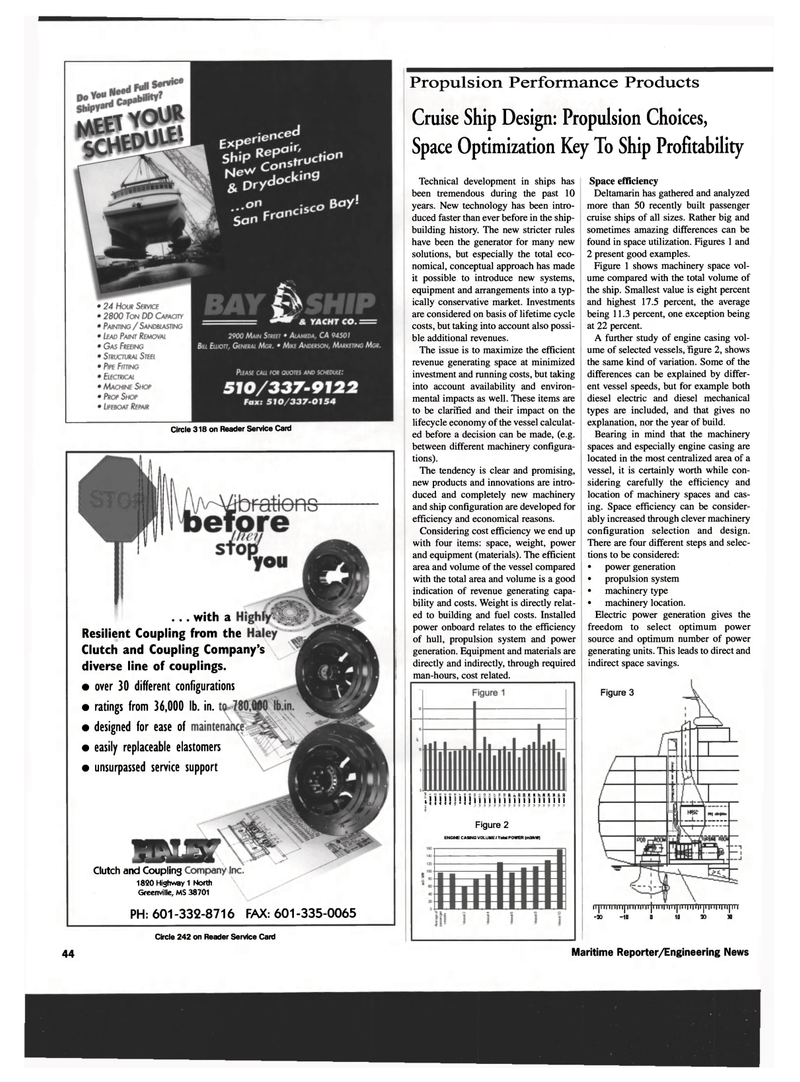
Page 56: of Maritime Reporter Magazine (October 1999)
Read this page in Pdf, Flash or Html5 edition of October 1999 Maritime Reporter Magazine
Circle 318 on Reader Service Card
Propulsion Performance Products
Cruise Ship Design: Propulsion Choices,
Space Optimization Key To Ship Profitability
Technical development in ships has been tremendous during the past 10 years. New technology has been intro- duced faster than ever before in the ship- building history. The new stricter rules have been the generator for many new solutions, but especially the total eco- nomical, conceptual approach has made it possible to introduce new systems, equipment and arrangements into a typ- ically conservative market. Investments are considered on basis of lifetime cycle costs, but taking into account also possi- ble additional revenues.
The issue is to maximize the efficient revenue generating space at minimized investment and running costs, but taking into account availability and environ- mental impacts as well. These items are to be clarified and their impact on the lifecycle economy of the vessel calculat- ed before a decision can be made, (e.g. between different machinery configura- tions).
The tendency is clear and promising, new products and innovations are intro- duced and completely new machinery and ship configuration are developed for efficiency and economical reasons.
Considering cost efficiency we end up with four items: space, weight, power and equipment (materials). The efficient area and volume of the vessel compared with the total area and volume is a good indication of revenue generating capa- bility and costs. Weight is directly relat- ed to building and fuel costs. Installed power onboard relates to the efficiency of hull, propulsion system and power generation. Equipment and materials are directly and indirectly, through required man-hours, cost related.
Circle 242 on Reader Service Card . . , R » n R K n H K ; R :J J j| ! | j 11 111 11 1 11 I 1111 1 111
Figure 2
ENGINE CASING VOLUME I Total POWER (m3AW)
Space efficiency
Deltamarin has gathered and analyzed more than 50 recently built passenger cruise ships of all sizes. Rather big and sometimes amazing differences can be found in space utilization. Figures 1 and 2 present good examples.
Figure 1 shows machinery space vol- ume compared with the total volume of the ship. Smallest value is eight percent and highest 17.5 percent, the average being 11.3 percent, one exception being at 22 percent.
A further study of engine casing vol- ume of selected vessels, figure 2, shows the same kind of variation. Some of the differences can be explained by differ- ent vessel speeds, but for example both diesel electric and diesel mechanical types are included, and that gives no explanation, nor the year of build.
Bearing in mind that the machinery spaces and especially engine casing are located in the most centralized area of a vessel, it is certainly worth while con- sidering carefully the efficiency and location of machinery spaces and cas- ing. Space efficiency can be consider- ably increased through clever machinery configuration selection and design.
There are four different steps and selec- tions to be considered: • power generation • propulsion system • machinery type • machinery location.
Electric power generation gives the freedom to select optimum power source and optimum number of power generating units. This leads to direct and indirect space savings.
Figure 3 ii|iiiiiiiii|iiiiiiiii|iiii|iiii|iii|i|f|i|i|ii|i|ii|iii -20 -1D D 10 » 30 44 Maritime Reporter/Engineering News . . . with a
Resilient Coupling from the
Clutch and Coupling Company's diverse line of couplings. • over 30 different configurations • ratings from 36,000 lb. in. • designed for ease of • easily replaceable elastomers • unsurpassed service support
Clutch and Coupling 1820 Highway 1 North
Greenville, MS 38701
PH: 601 -332-8716 FAX: 601 -335-0065

 55
55

 57
57
